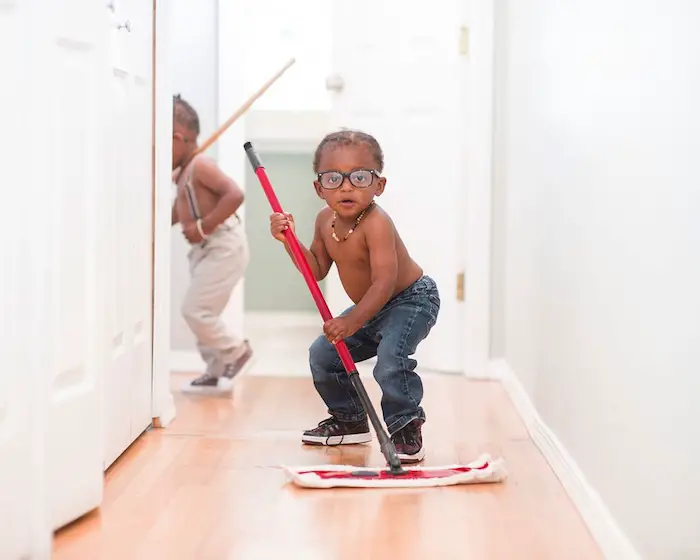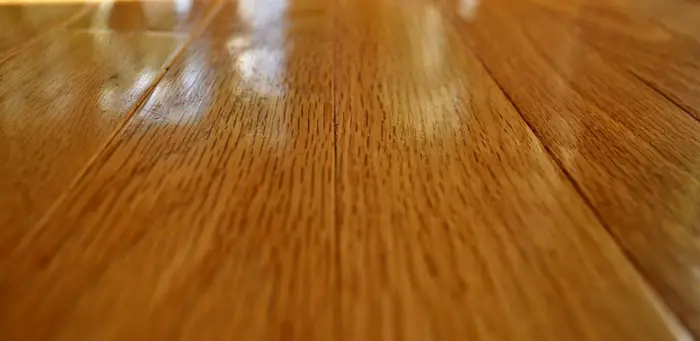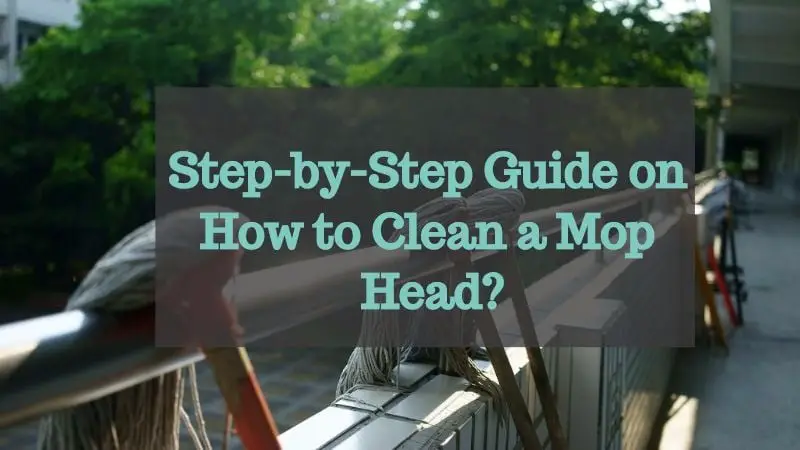Pet hair, baby food, and mud from dirty shoes, your floor takes a lot of beating throughout the day. While sweeping may work fine for daily cleanup of light soil and dust particles, traditional damp mopping by far remains the most effective way to deep clean the different types of floorings.
The high traffic areas such as kitchens, bathrooms, entryways, hallways, and dining areas should be vacuumed or swept in every 2-3 days and mopped at least once a week. A good thorough weekly mopping is what you need to make your floor spotlessly clean and well-sanitized.
In this article, I will share with you the general steps to mop a floor properly and then tell you what homemade cleaning solution works best for different types of floorings.
Steps To Mop A Floor Properly
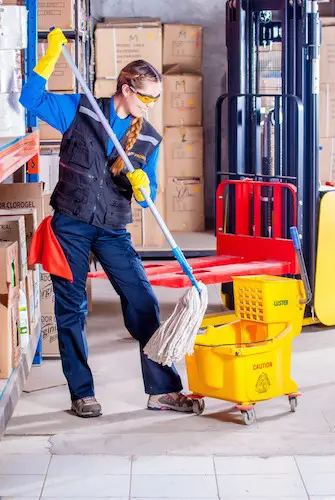
Before I start explaining the steps to mop the floor properly, here are a few essential cleaning tools you may need to complete the task.
- Sponge
- Microfiber cloth (see my reviews)
- A Floor Dust Mop
- String Mop
- Broom and dustpan
- Bucket
- Spray bottle
- Scrub brush
- Toothbrush
- Vacuum cleaners
#1. Before you start mopping
There are two important things you need to consider before you start mopping the floor. First, you will need to choose a suitable mop based on the flooring at your home. String mop or a strip mop, which one is right for you? I have listed the different types of mops to choose from, later in this article.
Secondly, you will need to prepare the right cleaning solution for your flooring type. I strongly suggest avoiding the products that advertise as ‘mop and shine’ because they contain strong chemicals that can damage the floor. I have also added a list of suitable cleaners based on different types of floor.
#2. Sweep and vacuum the floor
Moping without getting rid of the dust on the carpet or dry food particles on the floor will result in a dirty mess and negate the entire effort spent in cleaning. For best results, remove the light furniture, carpets, and rugs from the area you intend to clean. Start by sweeping the floor thoroughly and use a vacuum cleaner to get rid of smaller particles like hair, food crumbs etc.
Don’t drag large furniture as you will scratch the floor. Move only the small furniture items and dust the curtains, bed sheets, rugs, and carpets before you start sweeping so that the dirt and debris fall on the floor.
#3. Preparing the mopping solution
Fill the mopping bucket with hot water as it cleans quicker and better than cold water. Add the cleaning detergent or solution to the water. Avoid adding excess in the hope to clean better as this will only result in a concentrated soapy mess, making it difficult to rinse later.
#4. Wet and wring the mop
Dip the mop in the cleaning solution and wring it to remove excess water by hand or with the help if a wringer. Make sure the mop is wet enough to clean but not dripping with soapy water. If you try cleaning with too much water, this will not only damage the floor but also increase the drying time.
#5. Start mopping
I would suggest that you start mopping from the innermost room or area of the house and work your way outwards. Cover the area to be cleaned by mopping from one end to the other, and move backward as you do.
Make sure you stand on the un-mopped portion as you clean to keep a track of the area covered with the mop. If using a sponge mop, it’s always best to clean in straight lines. If you are using a rag mop, I would suggest that you clean in a figure-8 pattern to use your mop more effectively.
#6. Rub the stubborn and sticky spots
While most of the area will be cleaned easily by applying the same amount of pressure, there might be some sticky spots that require some extra effort. Rub back and forth over the spot, squat down if needed and apply some pressure downwards to remove the dirt. For hard-to-reach areas and edges, you may need to clean with paper towels or a sponge.
If you have scrubbed an area to get rid of sticky dirt, make sure you rinse again with clean water. Dip the mop a few times to get rid of the dirt on the surface and wring it out. Now, rinse the area with the damp mop to get a shiny and clean surface.
#7. Continue the process
Once you are done with the stubborn spots, continue mopping the remaining area of the house as mentioned above. As you mop, keep checking the cleansing solution water and wash water. If they turn visibly gray and dingy, empty the dirty water and refill the bucket with clean water.
If you are mopping the entire house, make sure you change the water frequently. I personally prefer to change after each room so that the dirty water from one room does not spread over other areas of the house.
#8. The final rinse
After you have mopped the entire floor area, it should look clean but there might be some soapy residue that requires a final rinse. In this step, mop the entire area once again with only hot water. It won’t take as much time as it did the first time because the floor is already clean and there are no more spots to rub.
#9. Let the floor and mop dry
Let the floor dry completely before anybody walks on it. If you have kids at home, doing the kid’s room first is a clever idea as you can tell them to stay in the room while the rest of the house is mopped. Switch on the ceiling or table fan to quicken the drying process.
After you are done with the mopping, let the mop and bucket dry completely under the sun to get rid of any bacteria or bad odor. When it’s completely dry, store away the mopping tools until next time.
Related article: A Quick on How to clean mop buckets
Mopping Requirement For Different Types Of Flooring
We like to beautify our houses with different types of laminate, tiles, or hardwood flooring. While they look impressive, they also need proper care. While the above instructions tell you how to mop a floor properly, some flooring may have special requirements. Read on to find out special cleaning needs for different types of flooring used at homes.
1. Laminate Flooring
While laminates may imitate the appearance of stone or hardwood, you will still need to care for them as laminates. As they are made with sun and light resistant materials, they don’t get damaged easily. While mopping a laminate floor you must avoid water from getting underneath the planks. Expert house cleaners suggest that you vacuum clean the floor and dry mop once a week.
You may spot clean the stubborn areas with a damp mop but don’t use too much water. If a plank looks damaged, resist your temptation of polishing the floor. It is better to replace the damaged plank with a new one.
2. Hardwood Flooring
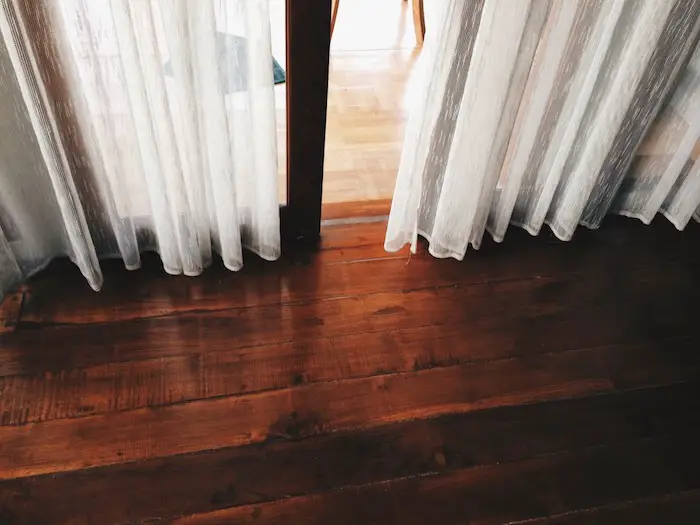
The hardwood flooring typically come in two finishes – wax and polyurethane. The sealed wood floorings may have a polyurethane, urethane, or polyacrylic coating that prevents water damage and stains. To mop hardwood floors, mix a ¼ cup of mild soap in a bucket of water and damp mop with a microfiber cloth to prevent excess moisture.
Hardwood floorings do not require a lot of maintenance. Just sweeping and vacuum cleaning every 2-3 days may be enough. Mop the high-traffic areas of the house once a week and the remaining you can do just once a month.
If you have waxed floors then mopping is out of questions. This type of floor can be easily damaged by water so keep the damp mops away. I would recommend that you sweep frequently, dust mop and vacuum once a week to keep the floor clean.
3. Cork Flooring
Floor made of natural cork look appealing due to its porosity but the same characteristic makes it vulnerable to water. As the material is highly absorbent, most cork flooring is sealed on the top but you still need to be careful.
Cleaning experts recommend vacuuming the clean cork flooring to prevent scratching. Wipe any spills immediately so that the floor does not absorb the liquid and mop once a week. To clean the flooring, use a solution made of a ¼ cup of vinegar and a little liquid dish soap.
Vinegar has an acidic quality which works with the soapy solution to break down the stubborn dirt and sanitize the floor. Don’t shake the solution vigorously as this may create suds. Gently mix the solution in a spray bottle. Spray the solution on one section at a time and mop with a damp microfiber.
4. Vinyl Flooring
Weekly cleaning is enough to keep your vinyl flooring well maintained and clean. I recommend the spray and dry mop technique to clean the dirty tiles. Mix warm water with a ¼ cup of vinegar and a drop of dish soap in a spray bottle. Spray the solution on the floor and clean with a damp cloth as you go.
To deep clean the floor, you may use a steam cleaner to get rid of the stubborn dirt or stains in the tile and grout. The steam not only loosens up the clogged dirt but also kills the bacteria.
5. Natural Stone Flooring
This type of flooring is extremely sensitive to acidic cleaning solutions, so never use vinegar to mop the floor. Even a small amount of vinegar, ammonia, or bleach could damage the surface. I recommend using only pH-neutral cleaners that would not react to the minerals in these surfaces.
If the stone flooring is unsealed, only use a damp mop to clean the surface and avoid any type of chemicals as they can damage the stone. Use a steam cleaner to get rid of the stubborn dirt.
6. Bamboo Flooring
Bamboo flooring is beautiful and highly sustainable. However, in some cases, they may be softer and more vulnerable to scratches and nicks. The strand bamboo flooring is the most durable of all but you will still need to be extra careful when sweeping dirt and debris.
To clean the bamboo floor, use the same cleaning mix – a ¼ cup of mild soap in a bucket of water. Clean the floor using a barely damp mop and keep a dry microfiber cloth handy to absorb any excess moisture.
7. Linoleum Flooring
This type of artificial flooring is made from a mixture of wood fiber, cork dust, linseed oil, resin, and limestone. Mineral pigments are used as coloring agents. To mop a linoleum floor, fill hot water in a spray bottle and add a few drops of dish soap to it.
Spritz on the floor, one section at a time, and then wipe with a damp cloth or microfiber mop. Make sure the floor air-dries immediately after you finish mopping. If it feels sticky to touch then mop once again with a clean damp cloth to get rid of any soapy residue.
8. Porcelain Tile Flooring
To keep your porcelain tile floor looking primp and propah, it’s enough to clean weekly using the spray and mop technique. In a spray bottle, mix together warm water, 1/4 cup vinegar and a drop of dishwasher soap. Spray one section of the floor at a time and wipe with a damp cloth.
For periodic deep cleaning, you may use a steam cleaner to remove dirt, grime, and stains from tiles and grouts. It not only cleans the floor but sanitizes too!
Different Types Of Mops Used For Cleaning
Mops used to be a simple tool with a stick and something to scrub with at the other end. However, the modern mops of today have highly evolved to accommodate the needs of different types of floors. The unique designs not only give you a clean floor but also help you mop the hard to reach areas with ease. Here are the different types of mops used for various floorings:
1. String Mops

This is the design people visualize when they think ‘mop’. The string mop comes with a bucket and there’s a special compartment to wring out excess water before you do the mopping. Almost all business areas use string mops as they are highly efficient at performing heavy duty cleaning on dirty floors.
2. Spin Mop
This belongs to the string mop family and follows the same mopping concept. However, this mopping system is more contemporary as the bucket comes with a hand or foot pedal to wring out the excess solution or dirty water from the mop head.
Spin mops (see my reviews) are not as large as the string mops, so you can use them for efficiently cleaning a house. The ease of use makes it a favorite with house cleaners.
3. Strip Mop
They are almost similar to the string mops but more versatile. When dry, the strip mops can work as a dust mop as the head has a series of strips that are useful in removing dust. They also serve as an efficient wet mop to clean the floor and the mop head can be machine washed after use.
4. Flat Mops
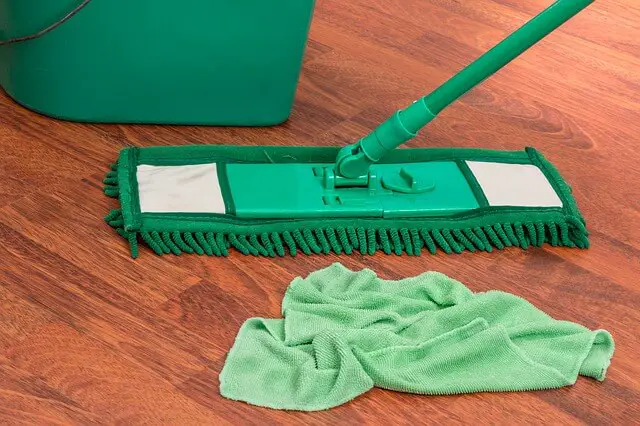
They are typically meant to clean small stains in areas that do not get a lot of traffic. There is a pad attached to the end to pick up dirt and wet grime. Some of the pads are washable, hence they can be cleaned in a washing machine and reused.
5. Sponge Mops
They have a similar design as flat mops, except that there is a sponge instead of a pad/ cloth at the other end. The sponge is capable of absorbing more dirty water than a pad, hence they can be used to clean bigger areas. They work best for liquid spills as the sponge can absorb more at a time.
6. Steam Mops
Unlike the string and strip mops that use a solution to clean the floor, the steam mops take the extra wetting and wringing steps out of the process. Although not as big as the string mops, they come with cartridges to dispense mopping solution.
When a button is pressed, a small amount of solution sprays out on the mop head, so you don’t need to move around the house with a bucket or a spray bottle. If you are looking for a steam mop, you can check my steam mop reviews
7. Dust Mops
This is used as a giant-sized broom for cleaning dry dirt and items like paper and other trash from the floor before the floor is mopped. They come handy to clean and pick up the dirt in commercial buildings and shopping center that are high traffic areas.
8. Microfiber Mop
The microfiber mops are gaining in popularity mainly due to their ability to absorb liquid like a sponge. They are built almost in the same way as a sponge mop. The biggest difference is that unlike a sponge mop, microfiber materials can be cleaned with ease.
9. Floor Mop
Similar to a dust mop, the floor mop helps in cleaning the dust, trash and other dry particles on the floor. They are often known as shop brooms because they look like a mop but have bristles at the end like a broom. The floor mop works best at commercial areas like warehouses and parking lots that get dusty and lots of trash fall on the ground.
10. Static Mop
This mop has a similar design like a shop broom but they may have a microfiber cloth in the place of bristles. As the mop head is made of microfibers, they are named static mops. They are used in the same way as floor or dust mops to pick foreign objects from the floor to the dustpan.
11. Disposable Mop
If the floor in your house or office does not require frequent cleaning, you may consider getting a disposable mop that can be connected to any dust mop. This gives you the freedom from cleaning the mop head as you can clean and discard after one use.
Related Questions
What is the best homemade floor cleaner?
The best all-purpose floor cleaning solution will be two cups of warm water, a ½ cup of white vinegar, three drops of mild liquid dish wash soap, and essential oils. However, please bear in mind that the requirement and restrictions may vary depending on the floor type.
Can you use dish soap to mop the floor
A few drops of dish soap in the bucket can help you cut the stubborn stains and make your old floor sparkle and shine. Make sure you don’t overdo as this can make your floor slippery, just 2-3 drops in a bucket of water and 1 drop in a spray bottle are enough.
Can you put essential oils in mop water
Yes, adding a few drops of essential oils to your homemade cleaning solution can sanitize the area and make it smell good too.
